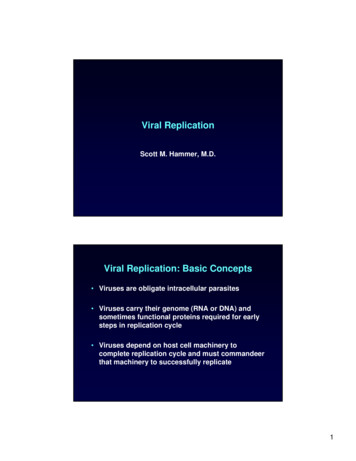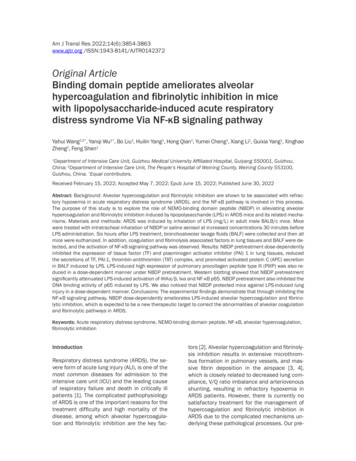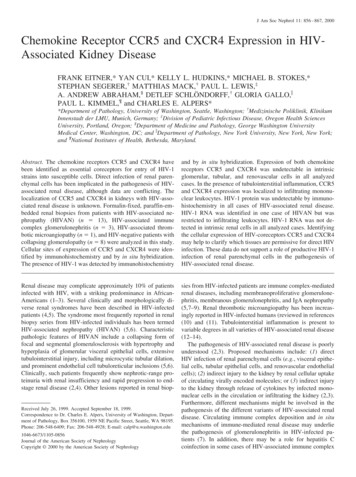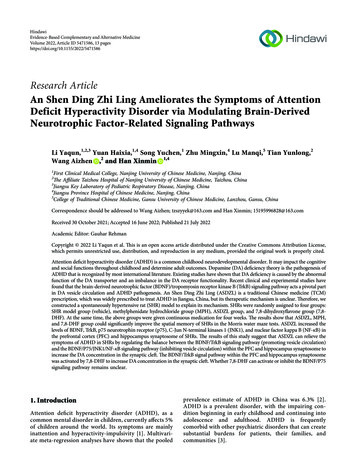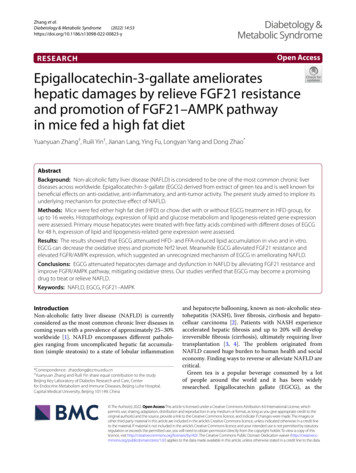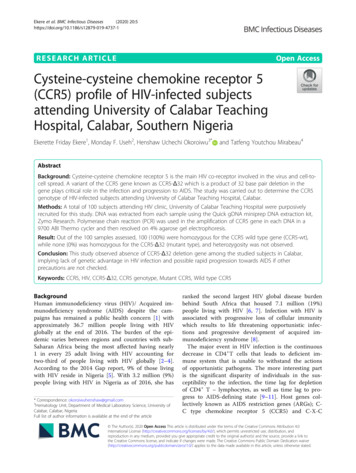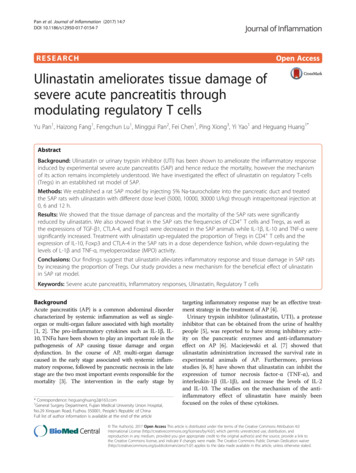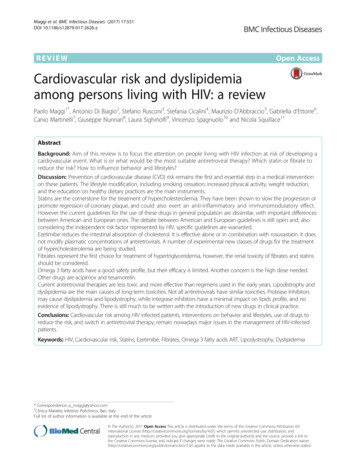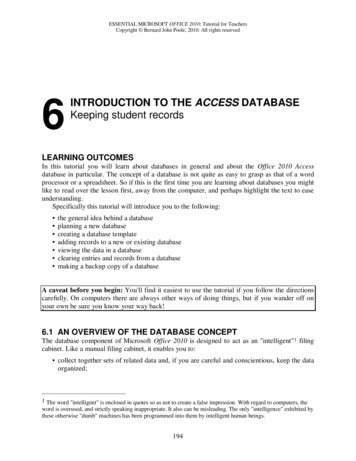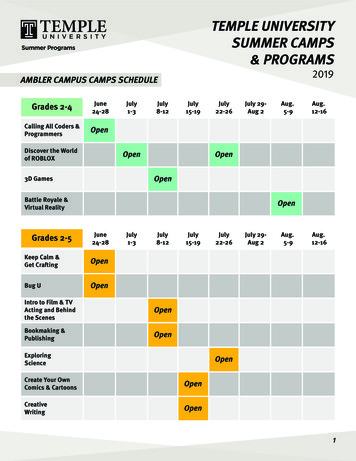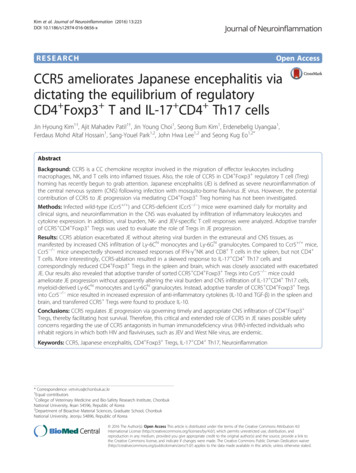
Transcription
Kim et al. Journal of Neuroinflammation (2016) 13:223DOI 10.1186/s12974-016-0656-xRESEARCHOpen AccessCCR5 ameliorates Japanese encephalitis viadictating the equilibrium of regulatoryCD4 Foxp3 T and IL-17 CD4 Th17 cellsJin Hyoung Kim1†, Ajit Mahadev Patil1†, Jin Young Choi1, Seong Bum Kim1, Erdenebelig Uyangaa1,Ferdaus Mohd Altaf Hossain1, Sang-Youel Park1,2, John Hwa Lee1,2 and Seong Kug Eo1,2*AbstractBackground: CCR5 is a CC chemokine receptor involved in the migration of effector leukocytes includingmacrophages, NK, and T cells into inflamed tissues. Also, the role of CCR5 in CD4 Foxp3 regulatory T cell (Treg)homing has recently begun to grab attention. Japanese encephalitis (JE) is defined as severe neuroinflammation ofthe central nervous system (CNS) following infection with mosquito-borne flavivirus JE virus. However, the potentialcontribution of CCR5 to JE progression via mediating CD4 Foxp3 Treg homing has not been investigated.Methods: Infected wild-type (Ccr5 / ) and CCR5-deficient (Ccr5 / ) mice were examined daily for mortality andclinical signs, and neuroinflammation in the CNS was evaluated by infiltration of inflammatory leukocytes andcytokine expression. In addition, viral burden, NK- and JEV-specific T cell responses were analyzed. Adoptive transferof CCR5 CD4 Foxp3 Tregs was used to evaluate the role of Tregs in JE progression.Results: CCR5 ablation exacerbated JE without altering viral burden in the extraneural and CNS tissues, asmanifested by increased CNS infiltration of Ly-6Chi monocytes and Ly-6Ghi granulocytes. Compared to Ccr5 / mice,Ccr5 / mice unexpectedly showed increased responses of IFN-γ NK and CD8 T cells in the spleen, but not CD4 T cells. More interestingly, CCR5-ablation resulted in a skewed response to IL-17 CD4 Th17 cells andcorrespondingly reduced CD4 Foxp3 Tregs in the spleen and brain, which was closely associated with exacerbatedJE. Our results also revealed that adoptive transfer of sorted CCR5 CD4 Foxp3 Tregs into Ccr5 / mice couldameliorate JE progression without apparently altering the viral burden and CNS infiltration of IL-17 CD4 Th17 cells,myeloid-derived Ly-6Chi monocytes and Ly-6Ghi granulocytes. Instead, adoptive transfer of CCR5 CD4 Foxp3 Tregsinto Ccr5 / mice resulted in increased expression of anti-inflammatory cytokines (IL-10 and TGF-β) in the spleen andbrain, and transferred CCR5 Tregs were found to produce IL-10.Conclusions: CCR5 regulates JE progression via governing timely and appropriate CNS infiltration of CD4 Foxp3 Tregs, thereby facilitating host survival. Therefore, this critical and extended role of CCR5 in JE raises possible safetyconcerns regarding the use of CCR5 antagonists in human immunodeficiency virus (HIV)-infected individuals whoinhabit regions in which both HIV and flaviviruses, such as JEV and West Nile virus, are endemic.Keywords: CCR5, Japanese encephalitis, CD4 Foxp3 Tregs, IL-17 CD4 Th17, Neuroinflammation* Correspondence: vetvirus@chonbuk.ac.kr†Equal contributors1College of Veterinary Medicine and Bio-Safety Research Institute, ChonbukNational University, Iksan 54596, Republic of Korea2Department of Bioactive Material Sciences, Graduate School, ChonbukNational University, Jeonju 54896, Republic of Korea 2016 The Author(s). Open Access This article is distributed under the terms of the Creative Commons Attribution 4.0International License (http://creativecommons.org/licenses/by/4.0/), which permits unrestricted use, distribution, andreproduction in any medium, provided you give appropriate credit to the original author(s) and the source, provide a link tothe Creative Commons license, and indicate if changes were made. The Creative Commons Public Domain Dedication o/1.0/) applies to the data made available in this article, unless otherwise stated.
Kim et al. Journal of Neuroinflammation (2016) 13:223BackgroundThe Flavivirus genus, which includes mosquito-bornedengue virus, Japanese encephalitis (JE) virus, and WestNile virus (WNV) [1–3], is associated with significantmorbidity and mortality due to fatal hemorrhagic feverand encephalitis. Of the flaviviruses, Japanese encephalitis virus (JEV) continues to be the leading cause of viralencephalitis in Asia and the Western Pacific. It poses anincreasing threat to global health and welfare, withapproximately 67,900 reported cases annually [4]. Dueto rapid changes in climate and demography, JEV iscurrently spreading to previously unaffected regionssuch as Indonesia, Pakistan, and northern Australia [5].The incubation period of JEV ranges from 5 to 15 daysand is fatal in 25 to 30 % cases, mostly in infants, and ahigh proportion of patients who survive have seriousneurological and psychiatric sequelae [4], for which JE isconsidered to be more fatal than WNV encephalitis,resulting in 3–5 % mortality (1100 death/29,000 symptomatic infections) [6]. Pathologically, JE is a severe neuroinflammation in the central nervous system (CNS)closely associated with the disruption of the blood–brainbarrier (BBB) [7]. Although little is known about thepathogenesis of JEV, considerable progress has beenmade in murine models [8, 9]. While JEV infects andkills neurons directly in the CNS, CNS invasion of JEVcauses the stimulation of microglia/glia and infiltratedleukocytes, leading to indirect neuronal killing via oversecreting pro-inflammatory cytokines (such as IL-6 andTNF-α) and soluble mediators that can induce neuronaldeath [10, 11]. This notion implies that JE is an immunopathological disease caused by uncontrolled overactivation of innate and adaptive immune cells, resultingin neurological disorders in the CNS. Therefore,adequate CNS infiltration and activation of peripheralimmune cells is considered to play a critical role in protecting hosts from viral encephalitis such as JE. Indeed,CNS infiltration and activation of peripheral leukocytesduring JE can cause profound damage if the reaction isexcessive or inappropriate [12]. Therefore, balancedCNS infiltration and activation of peripheral leukocytesshould be achieved to have a favorable prognosis of JEwithout tissue injury.Chemokine-mediated influx of peripheral leukocytesinto the CNS is believed to clear infection, but also be responsible for deleterious bystander neuronal damage associated with morbidity and, in some cases, increasedmortality. For example, CXCR3-deficient mice are foundto have enhanced CNS viral titers and mortality followingWNV infection [13], while these mice are protected fromlethal infection of lymphocytic choriomeningitis virus(LCMV) or cerebral malaria [14, 15], suggesting that thefinal outcome of encephalitis will depend on the nature ofthe pathogen and a range of host factors. Likewise, CCR5Page 2 of 19plays a critical role in recovery from flavivirus encephalitisvia appropriate CNS migration of peripheral leukocytes,including NK cells and CD4 /CD8 T cells [16–18].Indeed, the important role of CCR5 in human hostresponses to WNV encephalitis was demonstrated by aretrospective cohort study involving persons homozygousfor CCR5Δ32 [19], a loss-of-function mutation found in1–2 % of Caucasians [20]. Compared to individualswithout the mutation, persons carrying a homozygousCCR5Δ32 allele have an increased risk of symptomaticWNV infection. In view of the large number of humaninfections caused by flaviviruses and their global distribution, there are concerns about the potential adverse outcomes of CCR5 antagonist use for incurable infectiousdiseases, including human immunodeficiency virus (HIV).Furthermore, CD4 Foxp3 regulatory T cells (Tregs),which regulate excessive immune responses, are preferentially accumulated over effector T cells at sites of diseasedue to homing signals such as CCR5 [21–24]. CCR5dependent homing of CD4 Foxp3 Tregs at infectious sitesin parasitic pathogen infection models has been shown topromote pathogen persistence by regulating the magnitudeof pro-inflammatory responses and the equilibrium between IL-17 CD4 Th17 and CD4 Foxp3 Tregs [23, 24].Recently, a putative role for CD4 Foxp3 Tregs in thepathogenesis of fatal acute inflammatory diseases caused byflaviviruses has been suggested in the context of their regulatory function [25, 26]. However, the role of CD4 Foxp3 Tregs in flavivirus encephalitis remains elusive due to a lackof direct evidence. Presumably, CCR5-dependent recruitment of CD4 Foxp3 Tregs may affect the progression ofviral encephalitis via their regulatory function. To addressthe direct regulation of JE by CD4 Foxp3 Tregs in CCR5dependent homing context, we examined the role of CCR5in JE progression using CCR5-deficient (Ccr5 / ) mice inthis study. Our results revealed that Ccr5 / mice had exacerbated JE, ultimately resulting in high mortality without altering CNS viral burden, NK response, or T cell responsecompared to Ccr5 / mice. However, the increased susceptibility of Ccr5 / mice to JE was closely associatedwith decreased ratio of infiltrated CD4 Foxp3 Treg to IL17 CD4 Th17 in the CNS. This was directly confirmed bythe fact that injection of sorted CCR5 CD4 Foxp3 Tregsinto Ccr5 / mice provided ameliorated JE without affectingCNS infiltration of IL-17 CD4 Th17 cells or inflammatoryLy-6Chi monocytes. Therefore, our data suggest thatCCR5 could dictate JE progression by tightly regulating the balance between infiltrated CD4 Foxp3 Tregsand IL-17 CD4 Th17 cells in the CNS.MethodsAnimalsC57BL/6 (H-2b) mice (4- to 6-week-old female or male)were purchased from Samtako (O-San, Korea). CCR5
Kim et al. Journal of Neuroinflammation (2016) 13:223deficient (Ccr5 / ) mice and Foxp3GFP knock-in mice(H-2b), which co-express EGFP and regulatory T cellspecific transcription factor Foxp3 under the control ofan endogenous promoter, were obtained from JacksonLaboratories (Bar Harbor, ME). Ccr5 / ·Foxp3GFP micewere generated by crossing Ccr5 / mice with Foxp3GFPknock-in mice. All mice were genotyped and bred in theanimal facilities of Chonbuk National University.Cells, viruses, antibodies, and reagentsJEV Beijing-1 strain was obtained from the Green CrossResearch Institute (Suwon, Korea) and propagated in amosquito cell line (C6/36) using DMEM supplementedwith 2 % fetal bovine serum (FBS), penicillin (100 U/ml),and streptomycin (100 U/ml) [27]. C6/36 cells were infected with JEV Beijing-1 at a multiplicity of infection(MOI) of 0.1 and incubated in a humidified CO2 incubator at 28 C for 1 h. After absorption, the inoculum wasremoved and 7 ml of maintenance medium containing2 % FBS was added. At approximately 6–7 days postinfection (dpi), cultures of host cells showing 80–90 %cytopathic effect (CPE) were harvested. Virus stockswere titrated by conventional plaque assay or focusforming assay and stored in aliquots at 80 C until use.Monoclonal antibodies used for flow cytometric analysisand other experiments were obtained from eBioscience(San Diego, CA) or BD Biosciences (San Diego, CA),including fluorescein isothiocynate (FITC)-conjugatedanti-CD3ε (154-2C11), Ly6G (1A8), CD8 (53-67), phycoerythrin (PE)-conjugated anti-mouse CD11b (M1/70),Foxp3 (FJK-16s), IFN-γ (XMG1.2), F4/80(BM8), granzyme B (NGZB), peridinin chorophyll protein complex(PerCP)-conjugated anti-mouse Ly6C (HK 1.4), PEcyanine dye (Cy7)-anti-mouse NK1.1 (PL136), allophycocyanin (APC)-conjugated anti-mouse CD45(30-F11),IL-17 (eBio17B7), TNF-α (MP6-XT22), biotinconjugated anti-mouse IL-10 (JES5-16E3), and CD49b(DX5). Peptides of the defined I-Ab-restricted epitopesJEV NS1132–145 (TFVVDGPETKECPD), NS3563–574(WCFDGPRTNAIL), and H-2Db-restricted epitope JEVNS4B215–223 (SAVWNSTTA) were chemically synthesized at Peptron Inc. (Daejeon, Korea). JEV-specificprimers for viral RNA detection and primers specific forcytokines, chemokines, and transcription factors(Table 1) were synthesized at Bioneer Corp. (Daejeon,Korea) and used for PCR amplification of target genes.Quantitative real-time RT-PCR for determination of viralburden and cytokine expressionViral burden and the expression of cytokines (IL-1β, IL-6,IL-10, IL-17, IFN-γ) and chemokines (CCL2, CCL3, CCL4,CCL5, CXCL1, CXCL2) in inflammatory and lymphoidtissues were determined using quantitative SYBR Greenbased real-time RT-PCR (real-time qRT-PCR). Mice werePage 3 of 19intraperitoneally (i.p.) infected with JEV (3.0 107 pfu).Tissues including brain and spleen were harvested at 3, 4, 5,and 7 dpi following extensive cardiac perfusion with Hank’sbalanced salt solution (HBSS). Total RNAs were extractedfrom tissues using easyBLUE (iNtRON, Inc., Daejeon,Korea). Reverse transcription of total RNAs was performedusing High-Capacity cDNA Reverse Transcription Kits(Applied Biosystems, Foster, CA). These complementaryDNAs (cDNAs) were used for real-time qPCR using aCFX96 Real-Time PCR Detection system (Bio-Rad Laboratories, Hercules, CA). The reaction mixture contained 2 μlof template cDNA, 10 μl of 2 SYBR Primix Ex Taq, and200-nM primers at a final volume of 20 μl. The reactionswere denatured at 95 C for 30 s and then subjected to 45 cycles of 95 C for 5 s and 60 C for 20 s. After the reactioncycle was completed, the temperature was increased from65 to 95 C at a rate of 0.2 C/15 s, and the fluorescence wasmeasured every 5 s to construct a melting curve. A controlsample containing no template DNA was run with eachassay, and all determinations were performed at least in duplicates to ensure reproducibility. The authenticity of amplified product was determined by melting curve analysis.Viral RNA burden in infected samples was expressed asviral RNA copies per microgram of RNA. The expressionlevels of cytokines and chemokines were normalized to βactin. All data were analyzed using Bio-Rad CFX Managerversion 2.1 analysis software (Bio-Rad Laboratories).Infiltrated leukocyte analysis in the CNSMice infected with JEV were perfused with 30 ml ofHBSS at 3, 5, and 7 dpi via cardiac puncture of the leftventricle. The brains were harvested and homogenizedby gently pressing them through 100-mesh tissue sieves,after which they were digested with 25 μg/ml of collagenase type IV (Worthington Biochem, Freehold, NJ),0.1 μg/ml trypsin inhibitor Nα-p-tosyl-L-lysine chloromethyl ketone, 10 μg/ml DNase I (Amresco, Solon, OH),and 10 mM HEPE in HBSS at 37 C for 1 h with shaking. Cells were separated using Optiprep density gradient (18/10/5 %) centrifugation at 800 g for 30 min(Axis-Shield, Oslo, Norway), after which cells collectedfrom the 18 to 10 % interface were washed twice withPBS. Cells were then counted and stained for CD11b,Ly6G, Ly6C, CD45, F4/80, CD3, CD4, CD8, and NK1.1using directly conjugated antibodies (eBioscience) at 4 Cfor 30 min. Finally, these cells were fixed with 10 % formaldehyde. Data collection and analysis were performedwith a FACS Calibur flow cytometer (Becton DicksonMedical Systems, Sharon, MA) and the FlowJo (Tree Star,San Carlos, CA) software, respectively.Analysis and activation of NK cellsThe activity of NK cells was assessed by their capacity toproduce IFN-γ following brief stimulation with PMA and
Kim et al. Journal of Neuroinflammation (2016) 13:223Page 4 of 19Table 1 Specific primers for the expression of cytokines, chemokines, transcription factor, and JEV RNA used in real-time qRT-PCRGene namePrimer sequence (5′-3′)Position cDNAGene bank IDIL-1βFP: AAGTGATATTCTCCATGAGCTTTGT535–559NM 008361RP: �FP: TGG GAA ATC GTG GAA ATG AG209–228RP: CTC TGA AGG ACT CTG GCT TTG442–462FP: CAA CAT ACT GCT AAC CGA CTC CT253–275RP: TGA GGG TCT TCA GCT TCT CAC405–425NM 031168NM 010548FP: TCT GAT GCT GTT GCT GCT G87–105RP: ACG GTT AGA GGT AGT CTG AGG254–267NM 010552.3FP: CAG CAA CAA CAT AAG CGT CA119–220NM 008337.3NM 011333RP: CCT CAA ACT TGG CAA TAC JEVβ-actinFP: AAA AAC CTG GAT CGG AAC CAA347–367RP: CGG GTC AAC TTC ACA TTC AAA G426–447FP: CCA AGT CTT CTC AGC GCC AT158–177RP: GAA TCT TCC GGC TGT AGG AGA AG206–228FP: TTC TGT GCT CCA GGG TTC TC128–147RP: GAG GAG GCC TCT CCT GAA GT388–407FP: CCC TCA CCA TCA TCC TCA CT77–96RP: CTT CTT CTC TGG GTT GGC AC275–294FP: CGC TGC TGC TGC TGG CCA CC101–120RP: GGC TAT GAC TTG GGT TTG GG245–264FP: ATC CAG AGC TTG AGT GTG ACG C194–215RP: AAG GCA AAC TTT TTG ACC GC264–283FP: GGC CCT TCT CCA GGA CAG A551–570RP: GCT GAT CAT GGC TGG GTT GT642–662FP: AGT CCT CAT CTC TTC ACC TTC C1027–1048RP: GGC ACT CTT TCT CAT CTT GCC TG1116–1138FP: CCG CTG AGA GGG CTT CAC75–93RP: TGC AGG AGT AGG CCA CAT TAC283–304FP: GCC AGG GAA CCG CTT ATA TG823–843RP: GAC GAT CAT CTG GGT CAC ATT GT935–958FP: GGC TTA GCG CTC ACA TCC A4132–4150RP: GCT GGC CAC CCT CTC TTC TT4207–4226FP: TGG AAT CCT GTG GCA TCC ATG AAA C885–909RP: TAA AAC GCA GCT CAG TAA CAG TCC G1209–1233NM 011337.2NM 013652.2NM 013653.3NM 008176.3NM 009140.2NM 054039.2NM 008091.3AJ1232394AF241242AB920399.1NM 007393.3IL interleukin, FP forward primer, RP reverse primerionomycin (Sigma-Aldrich). Briefly, splenocytes were prepared from Ccr5 / and Ccr5 / mice at 2 dpi and stimulated with PMA and ionomycin (PMA at 50 ng/ml,ionomycin at 750 ng/ml) in the presence of monensin(2 μM) to induce the expression of IFN-γ for 1 h. Afterstimulation, cells were surface-stained with FITC-antimouse-CD3ε, PE-Cy7 anti-mouse NK1.1, biotin-conjugatedanti-mouse pan-NK cells (CD49b) [DX5] antibodies, andstreptavidin-APC at 4 C for 30 min. Cells were thenwashed twice with FACs buffer containing monensin. Afterfixation, cells were permeabilized with 1 permeabilizationbuffer (eBioscience) and stained intracellularly with PEanti-mouse IFN-γ (XMF1.2) antibody in permeabilizationbuffer at room temperature for 30 min. After cells werewashed with PBS twice, analysis was performed using aFACS Calibur flow cytometer and FlowJo software.JEV-specific CD4 and CD8 T cell responsesTo monitor CD4 and CD8 T cell responses specific forJEV, surviving mice were sacrificed at 7 dpi and splenocytes
Kim et al. Journal of Neuroinflammation (2016) 13:223were prepared. Erythrocytes were depleted by treatingsingle-cell suspensions with ammonium chloridecontaining Tris buffer (NH4Cl-Tris) at 37 C for 5 min.These splenocytes were then cultured in 96-well cultureplates (5 105 cells/well) with synthetic peptide epitopes(NS1132–145, NS3563–575, or NS4B215–225) in the presence of anti-CD154-PE for 12 h or for 6 h to evaluateCD4 orCD8 T cell responses, respectively [28, 29].Monensin (2 μM) was added to the antigenstimulated cells 6 h before harvest. Cells were washedwith PBS twice and surface-stained with FITC-antiCD4 or CD8 antibodies at 4 C for 30 min, followed bywashing twice with PBS containing monensin. After fixation, cells were washed twice with permeabilization buffer and stained with PE-anti-IFN-γ and APC-anti-TNF-αantibodies in permeabilization buffer at room temperaturefor 30 min. Finally, cells were washed twice with PBS andfixed using fixation buffer. Samples were analyzed using aFACS Calibur flow cytometer and FlowJo software.Intracellular staining for analysis of CD4 Th1, Th17, andTreg cellsTo monitor CD4 Th subsets, mice were infected i.p.with 3.0 107 pfu of JEV and sacrificed at 3 and 5 dpi.Brain leukocytes and splenocytes were prepared and cultured in 96-well plates (106 cells/well) with PMA/ionomycin (Th1 and Th17) in the presence of monensin(2 μM) at 37 C for 5 h. Stimulated cells were washedtwice with PBS and surface-stained with FITC-anti-CD4at 4 C for 30 min. After washing twice with PBS containing monensin and fixation, cells were washed twicewith permeabilization buffer (eBioscience, SanDiego, CA)and then stained with PerCP-anti-IFN-γ and APC-anti-IL17α in permeabilization buffer at room temperature for30 min. After washing twice with PBS, cells were fixedwith fixation buffer. To monitor Treg cells, brain leukocytes and splenocytes were surface-stained with FITCanti-CD4 markers on ice for 30 min, followed by fixationwith permeabilization concentrate buffer (eBioscience,sSan Diego, CA) at 4 C for 6 h. After fixation, cells werewashed twice with permeabilization and stained with PEanti-Foxp3 in permeabilization buffer at roomtemperature for 30 min. Sample analysis was performedwith a FACS Calibur flow cytometer.Purification and trafficking analysis of CCR5 CD4 Foxp3 Treg cellsCCR5 CD4 Fopx3 Treg cells were isolated from thespleen of Foxp3GFP knock-in mice using a FACS Ariasorter (Becton Dickson, Palo Alto, CA) with a final cellpurity of 95 %. CCR5 CD4 Fopx3 Treg cells were resuspended at density of 107 cells/ml in RPMI 1640 completemedium containing 10 % FBS, 1 % L-glutamine, 1 %nonessential amino acids, and 1 % penicillin/streptomycin.Page 5 of 19CCR5 CD4 Foxp3 Treg cells (2 106 cells/mouse) wereinjected intravenously into JEV-infected Ccr5 / mice at3 dpi. After injecting donor cells, brain and spleen tissueswere harvested at 5 dpi. Infiltrated cells were analyzed forthe presence of GFP-labeled cells using a FACS Caliburflow cytometer. CCR5 CD4 Fopx3 Treg cells were purified from Ccr5 / ·Foxp3GFP mice and adoptivelytransferred into Ccr5 / mice for the control group toCCR5 CD4 Foxp3 Treg-recipients. In some experiments,IL-10-producing CCR5 CD4 Foxp3GFP Tregs were detected by intracellular IL-10 staining combined with surface staining with CCR5 and CD4.Statistical analysisAll data are expressed as averages standard deviation.Statistically significant differences between groups wereanalyzed using an unpaired two-tailed Student’s t test forleukocyte population analysis and in vitro experiments orANOVA and post hoc testing for multiple comparisons ofthe means. The significance of differences in viral burdenand in vivo cytokine gene expression was evaluated byMann-Whitney test or unpaired two-tailed Student’s t test.Kaplan-Meier survival curves were analyzed using the logrank test. A p value 0.05 was considered to indicate statistical significance. All data were analyzed using the Prismsoftware (GraphPad Prism 4, San Diego, CA).ResultsCCR5 is essential for protection against JE butdispensable for control of viral replicationThe chemokine receptor CCR5 is believed to play a critical role in recovery from flavivirus encephalitis via efficient leukocyte trafficking to the brain [16–18]. CCR5 isalso a key mediator to recruit CD4 Foxp3 Tregs knownas regulatory CD4 T cell subset to dampen exacerbatedinflammation such as viral encephalitis [21–24]. Althoughthe role of CD4 Foxp4 Tregs in flavivirus encephalitis remains elusive, CCR5-dependent recruitment of CD4 Foxp3 Tregs may play certain roles in the control of encephalitis progression caused by flavivirus infection. Toaddress this issue of CCR5 in flavivirus encephalitis, wefirst confirmed the role of CCR5 in JE progression usingCCR5-deficient (Ccr5 / ) mice. After Ccr5 / and Ccr5 / mice were infected with JEV, surviving mice were monitored until 15 dpi (Fig. 1a). Mice in both groups showedsimilar clinical signs, starting with generalized piloerection, paresis, and rigidity and followed by progression intosevere neurological signs such as postural imbalance,ataxia, and generalized tonic-clonic seizure from 4 to6 dpi. However, CCR5 ablation resulted in marked increases in mortality after showing neurological disorders,with a mortality rate of 100 % for Ccr5 / mice vs. 54 %for Ccr5 / mice after JEV infection (3.0 107 pfu). Likewise, Ccr5 / mice showed a rapid increase in the
Kim et al. Journal of Neuroinflammation (2016) 13:22380604020p 0.0153051015Days post-infection6040202010 4Viral RNA copy numberper ug RNA210 110 06.07.0234**** *100808.0051051045Days post-infection710 6Ccr5Ccr5-/-10 310 210 110 011520Spinal cord / 010Days post-infection10 -110 -11120BrainCcr5Ccr5-/-0Ccr5 / Ccr5-/-605.010 6 / 10 310140Days post-infectionSpleendViral RNA copy numberper ug RNA8004.00cCcr5 / Ccr5-/-Viral RNA copy numberper ug RNA100100% Changein initial body weightbCcr5 / (n 15)Ccr5-/- (n 10)120% Paralysis rate% Survival rateaPage 6 of 192345Days post-infection7Ccr5 / Ccr5-/-10 510 410 310 210 110 010 -10123457Days post-infectionFig. 1 CCR5 is essential for protection against JE but dispensable for control of JEV replication. a Susceptibility of CCR5-ablated mice to JE. Ccr5 / andCcr5 / mice (4 to 6 weeks old, n 10–15) was inoculated i.p. with JEV (3.0 107 pfu). The survival rate was examined over 15 days. b Ratio of miceshowing neurological disorders during JE progression. Mice infected with JEV were examined every 6 h from 4 to 8 dpi. c Changes in body weight.Data are average percentages SD of body weight relative to that at the time of challenge. d Viral burden in lymphoid and inflammatory tissuesduring JE. Viral burden in lymphoid (spleen) and inflammatory tissues (brain and spinal cord) of infected mice (n 5–6) were assessed by real-timeqRT-PCR at the indicated time points. Viral RNA load was expressed as viral RNA copy number per microgram of total RNA (n 5–7). *p 0.05;**p 0.01 compared to the levels in the corresponding groupsfrequency of neurological disorder starting from 3 to 4 dpiafter JEV infection (3.0 107 pfu) with greater body weightloss, compared to Ccr5 / mice (Fig. 1b, c). However, theviral burden in the extraneural lymphoid tissue (spleen)and CNS (brain and spinal cord) of Ccr5 / mice was notincreased compared to that of Ccr5 / mice (Fig. 1d).Therefore, these results indicate that CCR5 ablation couldresult in an increased susceptibility to JE progression irrespective of viral replication.CCR5 ameliorates JE progressionTo further characterize CNS inflammation caused by JEVinfection in Ccr5 / and Ccr5 / mice, we assessed the infiltration of CD11b Ly-6Chi monocytes and CD11b Ly6Ghi granulocytes into CNS, because infiltration of thesecell populations derived from the myeloid cell lineage hasbeen used to evaluate CNS inflammation [30]. Our resultsrevealed that a markedly higher frequency of infiltratedCD11b Ly-6Chi monocytes and CD11b Ly-6Ghi granulocytes was retained in the brain of Ccr5 / mice at 3, 5, and7 dpi, compared to that in the brain of Ccr5 / mice(Fig. 2a). Similarly, the absolute number of CD11b Ly6Chi monocytes and CD11b Ly-6Ghi granulocytes infiltrating the brain of Ccr5 / mice was increased two- andthreefold at 5 dpi, respectively (Fig. 2b). Moreover,microglia cells contribute to the progression of encephalitis caused by some neurotropic viruses, such as WNV[31, 32]. Thus, four-color (CD11c/CD11b/CD45/F4/80)staining was used to distinguish resting from activatedmicroglia. Based on the CNS myeloid cell classificationmethod of Ford et al. [33], equivalent percentages and similar absolute numbers of resting microglia (CD11c CD11bhiCD45intF4/80 ) were detected in both Ccr5 / and Ccr5 / mice. However, activated microglia/macrophages (CD11c CD11bhiCD45hiF4/80 ) and other myeloidderived leukocytes (CD11c CD11bintCD45hiF4/80 ) in thebrain of Ccr5 / mice were detected at higher frequenciesand absolute numbers compared to the brain of Ccr5 / mice (Fig. 2c, d). These results indicate that CCR5 ablationcould exacerbate JE by enhancing the accumulation of
Kim et al. Journal of Neuroinflammation (2016) 8%5.22%0.66%d70.76%1.06%19.4%14.4%1.87%# CD11b Ly-6Chi monocytes(x103/brain)Ly-6G hiMockCcr5 / bJEV4.52%6.52%25# CD11b Ly-6Ghi neutrophils(x103/brain)aPage 7 of 19***20**151050Ccr5 / 150120Ccr5-/-Mock3 dpi5 dpi**907 dpi***60**300Ccr5 / Ccr5-/-8.0Ccr5 / Ccr5-/-Ly-6C hi0.18%Ccr5 -/-34.5%0.51%0.31%JEV 105hi1CD*4.02.00.00 1b6.0Ccr5 / Ccr5-/-0357Days /80F41CDtin1b hi45CD/80F412# CD3 CD8 T cells(x104/brain)0.39%# CD3 CD4 T cells(x104/brain)39.5% / # CD3-NK1.1 DX5 cells(x103/brain)MockCD11b hiCcr5 / 357Days post-infectionCcr5 / Ccr5-/-10864**200357Days post-infectionFig. 2 CCR5 regulates JE progression by altering the infiltration of leukocytes in the brain. a, b The frequency and number of Ly-6Chi monocytes andLy-6Ghi granulocytes in the brain. Ccr5 / and Ccr5 / mice were inoculated i.p. with JEV (3.0 107 pfu), and the frequency (a) and total number (b) ofLy-6Chi monocytes and Ly-6Ghi granulocytes in the CNS were determined by flow cytometric analysis at 3, 5, and 7 dpi using vigorous heart perfusion.Values in representative dot-plots denote the average percentage of the indicated population after gating on CD11b cells. c, d Resting and activatedmicroglia/macrophage number in the CNS. The number of resting (CD11c CD11bhiCD45intF4/80 ) and activated (CD11c-CD11bhiCD45hi F4/80 ) as wellas other myeloid-derived leukocytes (CD11bintCD45hi F4/80 ) was enumerated using flow cytometric analysis at 3 dpi. Values in representative dotplots denote the average percentage of the indicated population after gating on CD11c F4/80 cells. e Accumulated number of NK cells, CD4 , andCD8 T cells in the CNS. Total accumulated number of NK cells (CD3 NK1.1 DX5 ), CD4 (CD3 CD4 ), and CD8 (CD3 CD8 ) T cells in the CNS wereenumerated using flow cytometric analysis at 3, 5, and 7 dpi. Data are averages SD of the indicated cell populations derived from at least threeindependent experiments (n 4–5). *p 0.05; **p 0.01; ***p 0.001 compared with the levels of the indicated groupsinflammatory monocytes and granulocytes in the CNS,along with activation of microglia. CCR5 is also consideredto be involved in the recruitment of lymphoid lineagederived cells, including CD4 , CD8 T cells, and NK cells[34, 35], which may play a beneficial role in the control ofJE progression [36–38]. To better understand CNS inflammation in Ccr5 / mice following JEV infection, CD4 andCD8 T cells, and NK cells were enumerated in the brain.Infiltration of both CD4 and NK cells was evidenced by atransient increase in Ccr5 / mice at 3 dpi, after which thetotal number of CD4 and NK cells in Ccr5 / and Ccr5 / mice
RESEARCH Open Access CCR5 ameliorates Japanese encephalitis via dictating the equilibrium of regulatory CD4 Foxp3 T and IL-17 CD4 Th17 cells Jin Hyoung Kim1†, Ajit Mahadev Patil1†, Jin Young Choi1, Seong Bum Kim1, Erdenebelig Uyangaa1, Ferdaus Mohd Altaf Hossain1, Sang-Youel Park1,2, John Hwa Lee1,2 and Seong Kug Eo1,2* Abstract
